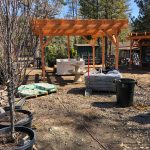It’s getting hot. I noticed this obvious little fact on the Fourth of July as we were running litter races up and down North Circle Drive in all our call-out gear with litters full of girl scouts throwing candy. After the parade we were covered in sweat and very happy to enjoy a cold beverage of our choice.
Whether you’re running litter races or hiking a trail, you can become dehydrated in any season, but the summer heat is obviously the worst offender.
Recognition
Heat can cause you problems quickly if you’re not prepared for it. You can lose up to 20 percent of your stamina with only two percent dehydration. That’s a big drop.
Even worse, when your system is low on water, you tend to lose mental acuity as well. This can lead to other, and perhaps worse, mistakes that can put you in real harm’s way.
As you get more and more dehydrated, your body quickly loses it’s ability to regulate its own temperature. As you may have guessed, this is not really a good thing. Loss of temperature regulation on a hot day in the back country can lead to both heat exhaustion and heat stroke, neither of which you really want to experience.
Heat exhaustion happens when a person exercises in a hot environment and sweating does not sufficiently release enough of the heat generated in their body. The body’s systems start to become overwhelmed as they become more and more dehydrated and lose temperature regulation.
Symptoms of heat exhaustion include profuse sweating, weakness, nausea, vomiting, headache, lightheadedness and muscle cramps. This is a serious condition that can escalate into a life threatening emergency.
Heat stroke is one of the most severe forms of heat illness. It can kill you or damage your brain and other internal organs irreparably. It can occur as a slow build up from conditions like heat exhaustion, or happen suddenly. Symptoms range from headache, lack of sweating despite heat, rapid heartbeat and breathing, nausea and disorientation to the extremes of seizures and coma.
The best treatment is to cool the person as rapidly as possible and calling for advanced medical aid as soon as possible.
Not really on my agenda for a fun day hiking.
Prevention
Make sure you drink, but don’t just chug water. Your body needs electrolytes in order to keep its systems balanced and running well.
You can actually overwater your body to the point that things start going wrong. This condition is called hyponatremia and can be pretty serious, with similar symptoms to heat exhaustion and heat stroke.
The only major difference? You’ll probably be urinating like a racehorse as your body attempts valiantly to rid itself of the excess fluids to restore electrolyte balance.
If you are eating as well as drinking, you’re likely to get enough of these electrolytes from your food. If not? Make sure to bring an electrolyte powder mix to add to some water or something like Gatorade to fill the need.
Carry enough water and be sure to actually drink it. Yes, it’s heavy, but it’s worth it! It also doesn’t help if your water is solidly wedged into the unreachable side pocket on your backpack. Either make a pact with your hiking partner to grab it for you whenever you stop, or invest in an easy access solution like a camelback or platypus water bladder and suction tube.
Know your resources: Most people don’t carry enough water, or know where it’s available if they need it in the high country. U.S. Forest Service rangers have a good idea of the conditions of water sources in the high country — ask at the Ranger Station (54270 Pinecrest in Idyllwild) front desk for an update before you head out.
Wear loosefitting, lightweight clothing. Wearing heavy clothing or those really hip tight leggings you just bought won’t allow your body to cool properly. Wear light-colored clothing, especially if you’re in the sun. Keep that awesome black workout shirt for your indoor Jazzercise class. Dark colored clothing absorbs heat. Light-colored clothing can help keep you cool by reflecting the sun’s rays. So, even if its not fashionable that beige hiking shirt is the way to go.
Get conditioned to heat. Limit the amount you spend hiking in the heat until you’re used to it. It’s just the beginning of the summer season.
You don’t have to run up to San Jacinto Peak during midday just yet, do you? People who are not used to hot weather (like us mountain folk) are especially vulnerable to heat-related illness. Remember, it can take up to several weeks for your body to adjust to hot weather.
Consider this your yearly temperature regulation reminder.










